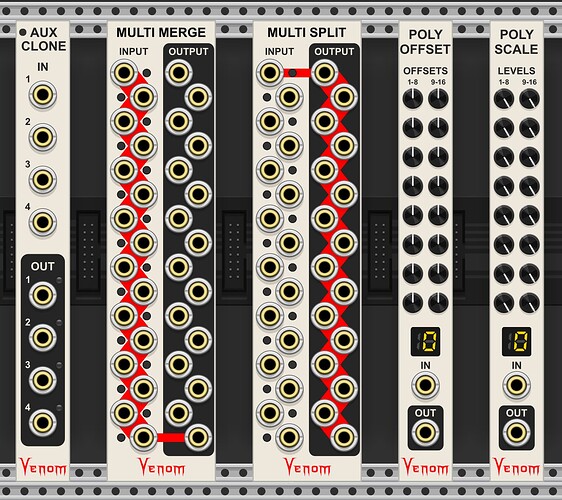This announcement is for two Venom releases - Version 2.6.1 that hit the library one week ago, and v2.7.0 that has been submitted and should be available in the library soon.Update 2024-03-30: v2.7.0 just hit the library!
Venom version 2.6.1
Benjolin Oscillator bug fix
Version 2.6.1 was a minor release. Its primary purpose was to fix a small bug in the Benjolin Oscillator that was attenuating the normalled CV to 20% of the intended value. This corrected version includes a context menu option to revert to the prior behavior, just so existing patch behavior does not change. By default, Benjolin Oscillators in pre-existing patches will use the old behavior, and new instances of the oscillator will use the corrected behavior.
Harmonic Quantizer detune parameters
The more exciting enhancement is the addition of detune capability to the Harmonic Quantizer (HQ). The HQ is often used with FM, AM, and other techniques to give musical modulation. Detuning the integral ratio just a bit can add richness and motion to the sound, much like detuning unison voices. But the sonic quality of the detuned output can change dramatically as frequency rises. So I added a Frequency Compensation knob to make the sonic quality more consistent across the audio spectrum.
Here is a patch and video demonstrating the effect of detune and frequency compensation:
HQ Detune Demo.vcv (16.7 KB)
Venom version 2.7.0
This is a major release, with 5 new polyphonic utility modules, as well as a bug fix for a serious issue with Venom expanders. As of writing this announcement, v2.7.0 is not yet available in the library. But you can download the version yourself at Release Release v2.7.0 · DaveBenham/VenomModules · GitHub. Simply download the appropriate binary for your platform and place it in the appropriate rack plugins folder.
Venom expander bug fix
The way I implemented Venom expanders exposed a bug or design flaw in the VCV API that could cause Venom to crash VCV Rack if a Venom module involved with expanders was deleted. I implemented a work-around such that the expander mechanism now works properly when modules are deleted. You can read a more technical description of the problem, along with my solution, at:
Auxiliary Clone Expander documentation link
Adds four additional poly input/output pairs to any of Cone Merge, Poly Clone, Poly Unison. Each channel of an input is cloned and merged with the other cloned channels at the output.
Multi Merge documentation link & Multi Split documentation link
I think these are the most interesting new modules in this release. They are extremely flexible and easy to use. Multi Merge allows you to combine multiple sets of mono and/or poly inputs, with each set getting its own merged poly output. Similarly, Multi Split can take multiple poly inputs, with each one split into any combination of mono and/or poly outputs, totally under your control.
Poly Offset documentation link & Poly Scale documentation link
Compact modules that give you offset or attenuverter controls for each channel of a poly input. They can increase the versatility of existing polyphonic modules. For example, the VCV filter only has one Cutoff knob, and one cutoff CV input with one attenuverter. That is fine if you are simply using the filter to support polyphony voices from a keyboard for example. But perhaps you want a use a single poly filter for multiple purposes. You could patch your poly modulation into the Poly Scale to give independent CV attenuation for each channel. Then patch the output to Poly Offset to give independent base cutoff values, and patch that output to the filter cutoff frequency at 100%. You can leave the filter cutoff and cutoff CV controls alone, and have full control of each channel at Poly Scale and Poly Offset.

